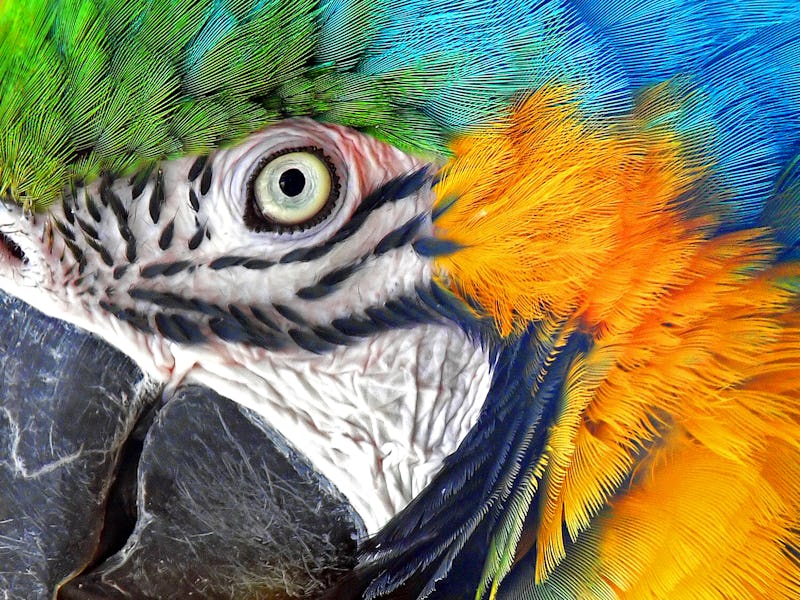When birds cry, scientists get closer to understanding human tears
Don't cry! It's only a new scientific finding.

Whether crying makes you feel better or worse emotionally, shedding tears is an important part of keeping our eyes healthy. Tears help shield our eyes from the rest of the world and keep them hydrated, helping to maintain homeostasis. For their part, humans shed between 15 and 30 gallons of tears each year.
Human tears contain electrolytes and other chemicals, like urea. New research finds that the composition of tears in birds and reptiles is actually pretty similar to that of our own, a boon to scientists hoping to understand why tears came to be evolutionary adaptations.
In a new study, scientists examined tear electrolytes across species of birds and reptiles. The researchers also studied how crystals form as tears dry. The animals studied included owls, hawks, macaws, one parrot species, sea turtles, tortoises, and caimans. They compared the animals' tears to those of 10 humans.
The research showed that all tear types had similar amounts of sodium and chloride, electrolytes also found in human tears. Bird and reptiles' electrolytes were more concentrated than humans' electrolytes, while the chemicals urea and protein were more concentrated in owls and sea turtles.
Arianne Oriá, professor at the Federal University of Bahia in Brazil, is the study's first author. She explains that similarities between humans and animals have to do with the environments they inhabit.
"In our studies, we observed that there are similarities in the tear composition of humans and other phylogenetically similar species, which inhabit similar environments," Oriá tells Inverse.
Sea turtle tears reflect their watery habitats, as do tears from caimans.
Tears in the animal kingdom — The work follows up on previous studies in mammals — not only humans, but also monkeys, dogs, horses, and camels. Oriá says that the new findings suggest that tears are important across the board, even to species that create them in a way that differs from mammals.
"Although birds and reptiles have different structures that are responsible for tear production, some components of this fluid [electrolytes] are present at similar concentrations as what is found in humans," Oriá said. "But the crystal structures are organized in different ways so that they guarantee the eyes´ health and an equilibrium with the various environments."
In addition to the chemical composition of tears, Oriá's team studied crystallization patterns as the tears dried. They discovered that macaws "presented a crystal arrangement similar to humans," while sea turtle and caiman tears dried and crystallized in a unique pattern that may reflect their watery habitats.
American barn owls were among the species studied.
"In this way, we can say that there is a direct influence of the environment on the tear composition," Oriá says, "a fact not observed when we tried to correlate diet interference, for example."
Those patterns, researchers say, can also help to detect certain types of eye diseases. In the future, that could help to advance human medicine, as scientists gain a better understanding of why tears — and the chemicals in them — are evolutionarily important adaptations.
"Our plan is to continue to understand which components are present in the tear film of other animal species, of different classes and different environments," Oriá says, "and to try to discover which components are the result of interaction with the environment and which are consigned to metabolism."
Abstract: To compare tear electrolytes and tear crystallization patterns in birds and reptiles, tears were sampled by Schirmer tear test from 10 animals each of Ara ararauna, Amazona aestiva, Tyto alba, Rupornis magnirostris, Chelonoidis carbonaria and Caiman latirostris, and 5 of Caretta caretta. The aliquots were pooled to assess concentrations of total protein, chloride, phosphorus, iron, sodium, potassium, calcium, and urea. For the tear ferning test, samples of each species were observed under a polarized light microscope at room temperature and humidity. Crystallization patterns were graded according Rolando and Masmali scales. There was more total protein and urea in owl and sea turtle tears, respectively, than in the other animals tested. Electrolyte balance was similar for all species, with higher sodium, chloride and iron. In birds, Rolando-scale grades of tear crystallization patterns ranged from I to II, and from 0 to 2 using the Masmali scale; in reptiles, grades were II to IV (Rolando) and 2 to 4 (Masmali). Crystallization arrangements of some species had higher scores, as caimans and sea turtles, possibly due to different the tear composition. Marine and lacustrine species presented higher. The ionic balance of lacrimal fluids of birds and reptiles was similar to that in humans, with higher values of sodium and chloride. However, a similar tear composition did not influence the crystal morphology. Crystallization classification suggested that higher grades and types are due to the different microelements present in the tears of wild species.
This article was originally published on